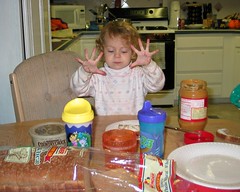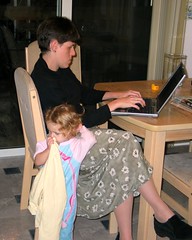This photo was taken by my brother on Christmas morning as my girls were opening their Christmas presents. Callie got some TicTacs in her stocking and, as Callie is wont to do, her first reaction is to share them with someone else.
Tic Tac?
A Problem Defined
What is it to be a nerd?
In junior high and high school nerdiness was mostly about being unpopular while also smarter than the popular kids. If Star Quarterback, being stronger and better looking than you, fails to match your A on the chemistry test then the reason, obviously, is because you’re a nerd. Popular kids are indeed amazing but you wouldn’t expect them to out-test a nerd, would you? That would be nerdy!
In the teenage years nerdiness only existed at the intersection of smart and unpopular. There were always people both smart and popular who were not nerds. In fact, if Star Quarterback failed to match Beautiful Cheerleader’s grade on the chemistry test, he might tease her that she was becoming a nerd. Should this insult be allowed to diminish her popularity then it would indeed mean that she was becoming a nerd. To avert that catastrophe Beautiful would be compelled to tease back that, no, Star got a C because he was just stupid. Equillibrium is restored.
But what about when we’re adults? Does nerdiness continue? What would constitue a nerdy adult? Does simply knowing more stuff than those around you make you a nerd? Or do you have to keep reading and learning new stuff for knowledge to count as nerdiness?
Does staying on the leading edge of technology and gadgetry indicate nerdiness at all? Does knowing a lot about any subject make you nerdy, or only when you know a lot about particular, nerdy subjects?
Close to the Boundaries
Like many other things in life, it’s safer not to be too close to any boundaries (like a fish at the edge of a school in shark infested waters, or someone walking on a ledge 200 meters high with no safety net).
This from a website article about the dangers of using the DOS program FDISK. Simple typos in FDISK can cause it to begin formatting your hard drive, and disk recovery tools can only recover files where the directory information nodes pointing to those files are still intact. Since the FDISK format starts at the root directory and destroys the root directory information node first, you generally cannot recover files from the root directory once you’ve accidentally started formatting the drive. This is bad as it’s the files in the root directory that allow your computer to do things like boot up when you turn it on.
I like that the author pulls a general principle out of this technical mess. If you like safety then finding yourself on a boundary is a bad place to be. Political constituency, religious practice, medical diagnosis, restaurant seating, cellular phone coverage, etc. You’ll have a less eventful ride when you’re located smack in the middle of your group.
In software engineering this boundary principle is called the “special case” — the bump in the data that cannot be processed by the simple, elegant algorithm that works fine for the bulk of the data. Oh, special cases can still be processed, but only after attaching bells and whistles — inelegance — to your elegant algorithm. Something like 70% of the work of programming goes into dealing with special cases.
Not Just Wi-Fi Anymore
We run a wireless network at home because that’s the easiest way for Tina to use her work laptop in the evenings and weekends. She likes working at the kitchen table, connected to the internet by the wireless convenience of electrical air. Of course this means we’re providing a means for our neighbors to unobtrusively use their laptops on our network too.
Today we had an electrician add some external power outlets to our house that we’ll use to power Christmas lights. Now passers-by can plug in and charge up their laptops while using our wireless network.
What We Do at Work All Day
Cora is 3YO(3 Years Old) and her friend Sammy is 4YO. They were pretending to talk to each other over their toy phones. Drawing on what her mommy must sound like to her when mommy’s on the phone, here’s one of the things that Cora said:
Yeah, I’m in the office. I’ve got to put my bugs away.
I’d like to make a couple of comments about that.
First, Cora’s mommy — my wife — works in the software industry. She’s at a high enough level within her project’s technical hierarchy that all bugs are ultimately her responsibility. At the same time she’s low enough in the managerial hierarchy that she still fixes bugs by looking at the source code rather than by hiring and firing other people to look at the source code for her. So anyway, this means that Tina spends a lot of time in the office and a lot of time on the phone talking about bugs with both her managers and technical staff. That’s where Cora got the idea about being “in the office” and having “to put [her] bugs away.” I can only imagine that Cora takes the word “bugs” in the sense of the word “crickets.”
Second, the “toy” phones that Cora and Sammy were playing with weren’t really toys: they were old cellular phones that their parents had given them when their parents bought new cellular phones. If you own stock in whatever company makes toy phones, sell. Who wants a hollow plastic phone when you can have a shiny Motorola that flips closed and clips to your waistband?
What I Do Here
- I’m not a good blogger as defined by quality of the content I produce or size of the audience that reads it. However I still like writing online because it gives me the feeling of having put my thoughts into the public square without the vulnerability that comes with anyone actually, you know, reading it.
- I really enjoy playing with server-side goodies like CMS and PHP scripts. My interest in the technology side of the web is enough for me to justify having my own website, whether the content there is useful to (or visited by!) anyone else or not.
- I write with my family and friends in mind, letting them know what I’ve been thinking lately.
- I have a penchant for writing about photos I’ve posted to Flickr.com.
- Occassionally I’ll swing for the fences and write something topical that I hope will get read in the general blogosphere. Even then don’t expect too much from me because, like I said in the first bullet, I’m not a very good blogger.
Aaaahhhh!
Peanut Butter Fingers
While it looks as though she’s trying to levitate a piece of bread off the plate using only the power of her mind, Callie’s actually showing off her peanut-butter-covered fingers. Peanut butter and jelly sandwiches have become a staple of toddler nourishment at our house since the toddler discovered that if she “helped” to make the sandwich then she’d probably end up covered in peanut butter and could lick it off of her fingers without getting into trouble. Licking peanut butter from your fingers when they’ve come straight from the peanut butter jar gets a fairly strong and negative reaction from bassdad. Helping to make your own sandwich — and getting messy in the meantime — well, who could blame you for that?
Callie waits
Tina is up late doing work on her computer. Callie is up late because she couldn’t sleep and wandered from her bedroom into the kitchen.
At our house if a kid hasn’t fallen asleep after giving it a good try then she is often allowed to get back up. She may not bother the adults or get wound up — we still want our kid-free adult time! — but is free to float about the house like a little ghost until she’s tired enough to try sleeping again.
Somersault
Here’s Callie doing a somersault. Callie has just turned two years old. I don’t know what the pediatric progress charts say about when a kid is supposed to attempt her first somersault, but Callie’s been doing them now for a while. She got the idea from her three year old sister and has been doing them seemingly since she developed enough balance while upright to put her head on the floor again and flip.
I don’t know if Callie’s ahead or behind the curve on agility activities like somersaults, but I do know that I wrestled and played and flipped her big sister a lot more at her age than I do Callie. When Cora was 2YO Callie was just a baby who stayed right where you put her. Cora and I would roll around the floor, jump, throw, somersault, and cart wheel to her little heart’s delight. She got a lot of exercise and agility practice with her old man.
Callie hasn’t gotten the same treatment because her sister isn’t a stationary baby but an active and heavy 3YO. If I throw Callie then I have to throw Cora. That’s hard! If I bounce Callie on my foot like a horsey then I have to bounce Cora too. Feel the burn.
So I’m not sure how to resolve this: a strategy to find play time away from Cora or a balm to soothe my conscience about how differently I’ve treated them.




